Choosing a baby gym can be exciting. It’s a source of fun and development for your little one. But with so many options on the market, it can also be overwhelming. This guide will help you navigate the features and find the perfect fit for your baby.
What is a Baby Gym?
A baby gym is a play mat with overhead arches that hold dangling toys. They provide a stimulating environment for babies to explore on their backs, tummies, and eventually, while sitting up.
Benefits of Baby Gyms
Baby gyms offer a wealth of benefits for your baby’s development:
Physical development:
Gyms encourage reaching, grasping, and kicking, which strengthens muscles and improves coordination.
Sensory development:
Colorful toys, contrasting patterns, and different textures stimulate baby’s senses.
Cognitive development:
Interactive toys and mirrors encourage exploration and problem-solving skills.
Social and emotional development:
Gyms provide a safe space for tummy time, which can be challenging for newborns.
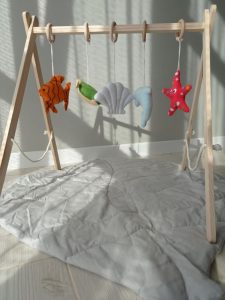
Things to Consider When Choosing a Baby Gym
Here are some key factors to consider when choosing a baby gym:
- Age and developmental stage: Gyms with high-contrast colors and simple toys are best for newborns. As your baby grows, look for gyms with more complex features and activities.
- Play mat: Consider the size, padding, and ease of cleaning. A thick mat provides comfort and protects your baby during tummy time. A washable mat is easy to keep clean.
- Arches and toys: Look for adjustable arches that allow you to change the position of the toys. Removable toys allow for easy cleaning and customization.
- Music and sound: Some gyms have musical features or crinkly toys. These can be fun, but too much stimulation can overwhelm young babies.
Types of Baby Gyms
There are several different types of baby gyms available, each with its own advantages:
- Traditional Gyms: These gyms have a play mat, arches, and dangling toys. They are a versatile option that can be used for a variety of activities.
- Activity Gyms: These gyms come with additional features like ball pits, bouncy seats, and play tunnels. They can provide a lot of entertainment for your baby, but they may also be bulkier and more expensive.
- Montessori Gyms: These gyms focus on natural materials and open-ended play. They may not have a lot of bells and whistles, but they encourage creativity and exploration.
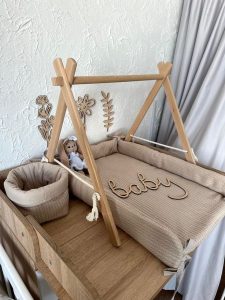
Examples of Popular Baby Gyms
Here are a few popular baby gyms to consider, each with different strengths:
- Lovevery Play Gym: This gym is known for its high-quality materials, Montessori-inspired design, and focus on developmental stages.
- Skip Hop Farmstand Grow & Play Activity Gym: This gym folds up for easy storage and has a variety of farm-themed toys.
- Baby Einstein 4-in-1 Kickin’ Tunes Music & Language Discovery Gym: This affordable gym features a variety of musical toys and promotes language development.
- Infantino Twist & Fold Activity Gym: This gym has a unique folding design that makes it portable and easy to store.
The best baby gym for you will depend on your individual needs and preferences. Consider your baby’s age, developmental stage, and what features are most important to you. With a little research, you can find a gym that will provide hours of fun and learning for your little one.
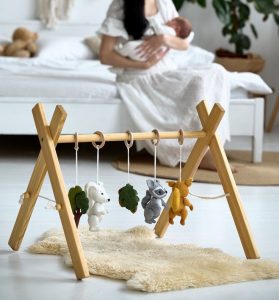
Making Your Choice
There’s no single “best” baby gym. The ideal choice depends on your baby’s age, interests, and your preferences. Here are some additional factors to consider:
-
Safety: Pick a gym with sturdy construction and securely attached toys. Look for certifications that meet safety standards.
-
Budget: Baby gyms range in price. Consider how long you’ll use the gym and what features are most important to you.
-
Durability: Choose a gym made with high-quality materials that can withstand plenty of pulling, batting, and kicking.
-
Portability: If you plan to move the gym around the house or take it with you when you travel, consider a foldable or lightweight option.
-
Style: Gyms come in a variety of colors and themes. Choose one that complements your nursery or home décor.
Finding the Perfect Fit
Once you’ve considered these factors, you can start browsing specific gyms. Here are some tips for making your final decision:
-
Read reviews. See what other parents have to say about different baby gyms.
-
Look for videos. Watching videos can give you a good sense of a gym’s features and how babies interact with it.
-
Visit a store. If possible, go to a store and see the gyms in person. This will allow you to compare the size, quality, and features of different options.
The most important thing is to choose a baby gym that your baby enjoys and will use. Pay attention to your baby’s cues and interests when making your decision.
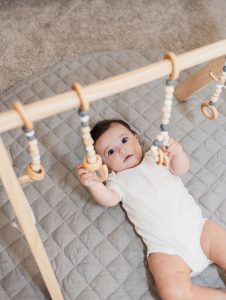
Getting the Most Out of Your Baby Gym
Here are some ideas to help your baby get the most out of their gym:
-
Change things up: Regularly rotate the hanging toys to keep things interesting for your baby. You can also move the gym to different locations in your house to provide a change of scenery.
-
Get down on their level: Spend time lying on the play mat with your baby. This will encourage interaction and communication.
-
Narrate your baby’s play: Talk to your baby about the gym and the toys. Describe what they’re doing and what they see.
-
Incorporate tummy time: Tummy time is important for strengthening your baby’s neck and back muscles. Use the gym as an incentive to encourage your baby to spend time on their tummy.
-
Sing songs and play peek-a-boo: Use the gym toys and mats as props to keep playtime fun and engaging.
By following these tips, you can help your baby get the most developmental and emotional benefits from their baby gym.
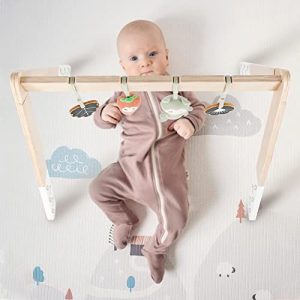
Beyond the Gym: Encouraging Play
Baby gyms are fantastic for development, but playtime shouldn’t be confined to the gym. Here are some ways to encourage exploration and learning throughout the day:
-
Floor time: Let your baby have plenty of unstructured playtime on a safe, comfy play mat. This allows them to roll, crawl, and explore at their own pace.
-
Household exploration: Encourage safe exploration of your home. Colorful containers, pots and pans, and safe chew toys can all be fascinating to little ones.
-
Sensory experiences: Provide opportunities for your baby to explore different textures, sounds, and sights. Safe items like crinkly fabrics, rattles, and contrasting colored toys can spark curiosity.
-
Singing and talking: Narrate your day-to-day activities, sing songs, and talk in silly voices. This constant stream of language helps your baby learn and bond with you.
-
Simple games: Play peek-a-boo, pat-a-cake, or other traditional baby games. These simple interactions create joy and connection.
Remember, the best playthings for your baby are often the most ordinary ones. By providing a safe and stimulating environment and interacting with your baby throughout the day, you’ll be fostering their development in countless ways.
